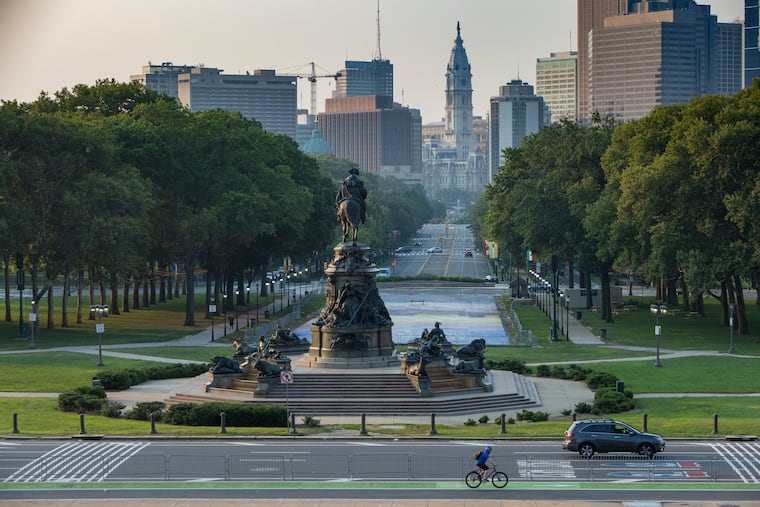Improving the Ben Franklin Parkway demands smarts and art, not costly engineering | Opinion
The redesign should include public artists and an explicit recognition of the city’s diversity of neighborhoods.

On July 14, three acclaimed teams of designers presented preliminary ideas about how to transform the Benjamin Franklin Parkway into a “21st century” public space. Two issues deserve critical consideration: mobility and public art.
At the core of the design effort is the city’s aim to make the Parkway into a “More Park, Less Way” destination for Philadelphians and visitors to enjoy on a year-round basis. True to this aim, all three teams presented a long-term, vehicle-free vision for the Parkway. Ideas ranged from “disengaging” the Parkway from the Schuylkill Expressway access roadways, to widening the existing tunnel at the foot of the museum steps to accommodate two-way traffic, to creating a “ring-road” just for traffic, freeing the Parkway for pedestrians. These ideas may be worth exploring. But they are misguided.
» READ MORE: Urban forest or urban boulevard? Philadelphia tries to reimagine the Parkway — again.
Full disclosure: I was part of one of the teams that submitted qualifications in response to the city’s request for proposals to reenvision the Parkway, but not among the finalists. The opinions expressed here are my own and reflect what I have long wanted to see in the redesign.
It’s clear the Parkway needs to do a better job of managing traffic and protecting cyclists and pedestrians. But any new design should forego solutions that demand substantial and costly roadway engineering, and focus instead on traffic management that is flexible, based on intelligent — and green — technologies.
The technology exists today, and will only improve in the coming years, to manage traffic — pedestrian and vehicular — through “intelligent” monitoring and programming systems. These technologies would monitor traffic patterns, allowing officials to close or open Parkway lanes for vehicular traffic, change their direction, and increase or restrict volumes according to, say, rush hour demands, planned mass gatherings, and every form of usage in between. City-based alerts similar to weather alerts could be instituted to advise motorists of traffic restrictions or changes on the Parkway. We could enlist Google and Apple and other mapmakers to show desirable routes outside the Parkway when the area is inundated with pedestrians (similar to roadway construction advisories). These would be “soft” vs. “hard” improvements, potentially costing far less than a wholesale reconfiguration of the roadways.
The three selected teams also touched on art and culture. This is an essential element of any plan, given that public art is a defining Philadelphia quality.
» READ MORE: Time for a more people-centered Ben Franklin Parkway | Editorial
Philadelphia’s Percent for Art program — which stipulates that any new projects or major renovations set aside 1% of the budget for site-specific art — is the oldest in the nation. It was pioneered in 1959 by the Philadelphia Redevelopment Authority to integrate site-specific works, nearly 400 of which have been installed. To these are added many more by the city Percent for Art program, also initiated in 1959, to say nothing of the thousands of murals implemented by Mural Arts Philadelphia. In the past decade, the PRA’s Percent for Art program (of which I am a committee member) has developed specific guidelines to advance community engagement and education as an integral part of commissioned works and to gain community input in the art itself.
How can communities help create art for the Parkway? For starters, all three teams should include on the roster a public artist or public art consultant to help answer the question. More importantly, there should be an explicit recognition of the city’s diversity of neighborhoods. Philadelphia is composed of many different neighborhoods — with nearly 200 neighborhood names, in fact. As the city’s preeminent common ground, the Parkway should manifest such diversity as a part of its physical signature. Artists could work with each neighborhood to determine how their history and culture could find expression on the Parkway, revealing in the process how the place can best be programmed and managed for all. Distinct works could then emerge over time — a grand art project — cementing the spirit of the city along the length of the corridor and all its adjoining spaces. The Parkway would become a must-visit hub of public art, supplementing the institutional offerings that frame it and contributing further to the city’s burgeoning creative economy.
The three selected teams proposed many good ideas to activate the Parkway. All of them can coexist alongside smartly managed traffic and community-based public art.
Ignacio F. Bunster-Ossa heads the Landscape Urbanism and Resilience practice at The Collaborative.